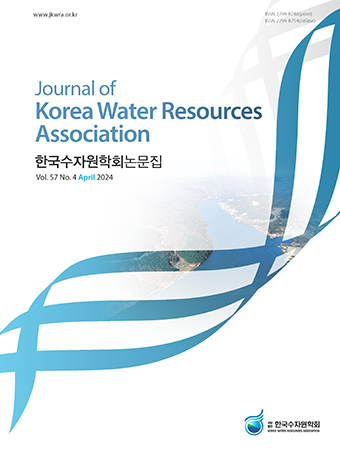Abstract
References
Akaike, H. (1974). “A new look at the statistical model identification.” IEEE Transactions on Automatic Control, Vol. 19, No. 6, pp. 716-723. Bonaccorse, B., Cancelliere, A., and Rossi, G. (2003). “An analytical formulation of return period of drought severity.” Vol. 17, No. 3, pp. 157-174. Chun, S.-Y., Kim, Y.-T., and Kwon, H.-H. (2015). “Drought frequency analysis using hidden markov chain model and bivariate copula function.” Journal of Korea Water Resource Associate, Vol. 48, No. 12, pp. 969-979. Fernández, B., and Salas, J. D. (1999). “Return period and risk of hydrologic events. I: Mathematical formulation.” Journal of Hydrologic Engineering, Vol. 4, No. 4, pp. 297-307. Findley, D. F. (1991). “Counter examples to Parsimony and BIC.” Annals of the Institute of Statistical Mathematics, Vol. 43, No. 3, pp. 505-514. Gelfand, A. E., and Smith, A. F. (1990). “Sampling-based approaches to calculating marginal densities.” Journal of the American Statistical Association, Vol. 85, No. 410, pp. 398-409. Gelman, A., and Hill, J. (2006). Data analysis using regression and multilevel/hierarchical model. Cambridge University Press. Gelman, A., Carlin, J. B., Stern, H. S., and Rubin, D. B. (2003). Bayesian data analysis. CRC press, United States of America. Gelman, A., Carlin, J. B., Stern, H. S., and Rubin, D. B. (2004). Bayesian data analysis (2nd ed.). Boca Raton: Chapman and Hall/CRC. Geman, S., and Geman, D. (1984). “Stochastic relaxation, Gibbs distributions, and the Bayesian restoration of images.” IEEE Transactions on Pattern Analysis and Machine Intelligence, Vol. 6, pp. 721-741. Kim, J. S., Jain, S., and Yoon, S. K. (2012). “Warm season streamflow variability in the Korean Han river basin: links with atmos-pheric teleconnections.” International Journal of Climatology, doi: 10. 1002/joc.2290. Kim, J.-Y., So, B.-J., Kim, T.-W., and Kwon, H.-H. (2016). “A development of trivariate drought frequency analysis approach using copula function.” Journal of Korea Water Resource Associate, Vol. 49, No. 10, pp. 823-833. Kim, T.-W., Valdés, J. B., and Yoo, C. S. (2003). “Nonparametric approach for estimating return periods of droughts in arid regions.” Journal of Hydrologic Engineering, Vol. 8, No. 5, pp. 237-246. Kim, T.-W., Valdés, J. B., and Yoo, C. S. (2006). “Nonparametric approach for bivariate drought characterization using palmer drought index.” Journal of Hydrologic Engineering, Vol. 11, No. 2, pp. 134-143. Kuo, J.-T., Hsu, Y.-C., Tung, Y.-K., Yeh, K.-C., and Wu, J.-D. (2008). “Dam overtopping risk assessment considering inspection program.” Stochastic Environmental Research and Risk Assessment, Vol. 22, pp. 303-313. Kwak, J. W., Kim, D. G., Lee, J. S., and Kim, H. S. (2012). “Hydrological drought analysis using copula theory.” Journal of the Korea Society of Civil Engineers, Vol. 32, No. 3B, pp. 161-168. Kwon, H.-H, Casey, B., and Lall, U. (2008). “Climate informed flood frequency analysis and prediction in montana using hierarchical Bayesian modeling.” Geophysical Research Letters, Vol. 35, L05404. Kwon, H.-H., and Lall, U. (2016). “A copula-based nonstationary frequency analysis for the 2012~2015 drought in California.” Water Resources Research, Vol. 52, No. 7, pp. 5662-5675. Lee, J.-J., and Kwon, H.-H. (2011). “Analysis on spatio-temporal pattern and regionalization of extreme rainfall data.” Journal of Korean Society of Civil Engineers, Vol. 31, No. 1B, pp. 13-20. Lee, T. S., and Son, C. Y. (2016). “Analyzing the drought event in 2015 through statistical drought frequency analysis.” Journal of Korea Water Resource Associate, Vol. 49, No. 3, pp. 177-186. Melching, C. S., Wenzel, H., and Yen, B. C. (1987). “Application of system reliability analysis to flood forecasting.” Application of Frequency and Risk in Water Resources, Edited by V. P. Singh, Reidel Publishing Company. Na, B.-K., Kim, J.-Y., Kwon, H.-H., and Lim, J.-Y. (2014). “Improve-ment of hydrologic dam risk analysis model considering uncertaintyof hydrologic analysis process.” Journal of Korea Water Resource Associate, Vol. 47, No. 10, pp. 853-865. Shiau, J. T., and Modarres, R. (2009). “Copula-based drought severityduration-frequency analysis in Iran.” Meteorological Applacations, Vol. 16, No. 4, pp. 481-489. Shiau, J.-T., and Shen, H. W. (2001). “Recurrence analysis of hydrologic droughts of differing severity.” Journal of Water Resources Planning and Management, Vol. 127, No. 1, pp. 30-40. Yevjevich, V. (1967). “An objective approach to definitions and investigations of continental hydrologic droughts.” Hydrology Paper, No. 23, Colorado State University, Fort Collins, pp. 4-18. Yoo, J. Y., Lee, J. H., and Kim, T. W. (2016). “Estimation of drought risk through the bivariate drought frequency analysis using copula functions.” Journal of Korea Water Resource Associate, Vol. 49, No. 3, pp. 217-225.
Information
- Publisher :KOREA WATER RESOURECES ASSOCIATION
- Publisher(Ko) :한국수자원학회
- Journal Title :Journal of Korea Water Resources Association
- Journal Title(Ko) :한국수자원학회 논문집
- Volume : 50
- No :11
- Pages :745-758
- Received Date : 2017-08-23
- Revised Date : 2017-09-20
- Accepted Date : 2017-09-20
- DOI :https://doi.org/10.3741/JKWRA.2017.50.11.745




 Journal of Korea Water Resources Association
Journal of Korea Water Resources Association










